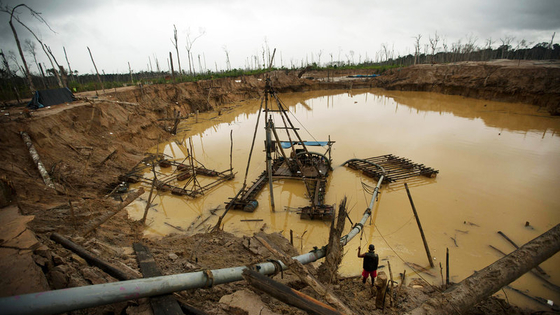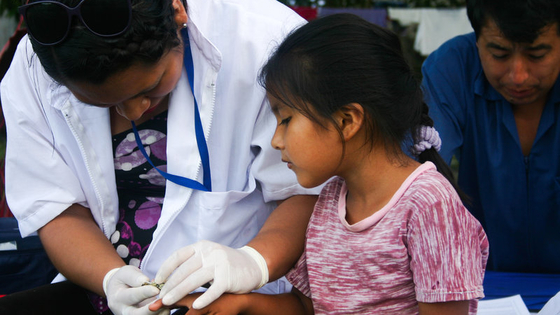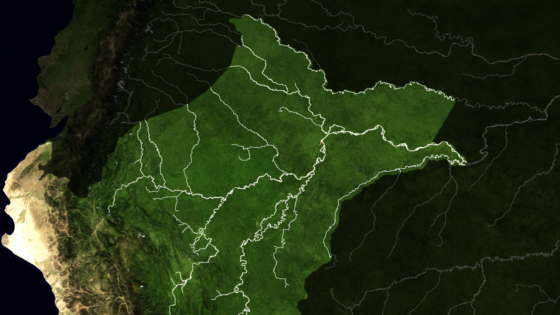LUCIA: Land use, climate and infections in Western Amazonia (CRN 3036)

Project information
Universidade Federal de Minas Gerais (Brasil)
Policy brief: Environmental conditions affect human health in the Amazon forest
Results
This is a summary of the most salient project results. For further information see the project website, project papers or contact the investigators directly.
The project is in the data acquisition stage on ecological and social factors determining insect born disease incidence: in one Amazonian municipality, 180 household questionnaires on land use, socioeconomics and demography, history of environmental or health shocks, and the perceptions of a planned hydroelectric dam in the municipality; and data on all malaria cases were collected from the National Health Foundation office. This database is being integrated into a GIS and linked to a previous 2010 field survey. To provide ecological context, a refined high-resolution classification of land use is implemented using the spatial contexts of pixels, including tree shadows or water, instead of the pixel-by-pixel spectral classification on TM Landsat 5 imagery.
In Peru, data on 313 households are being cleaned: anthropometric measurements on family members, attitudes, satisfaction, vulnerability and security, and hair-mercury levels. This is related to an original 1999 survey of 100 farms which through subdivision now include some 300 households.
In Ecuador, 225 questionnaires of household heads and 178 of spouses were collected for the first time on tablets. It surveyed dengue and leishmaniasis risk, and established links to the ecology of leishmaniasis vectors. Mercury toxicity, emerging chronic disease and neurological assessments of children exposed to mercury were examined by a PhD student of criminal justice. Results from the US team on fish consumption and mercury exposure were provided to the Ministry of Health.
Outreach
Using NASA satellite data to predict malaria outbreaks
The study of chronic diseases in Peru. Jaime Miranda | TEDxTukuy (in Spanish)
Project investigators
Ulisses Confalonieri (pmags@ensp.fiocruz.br)
UFMG/CEDEPLAR, Brazil
Laura Rodriguez Wong (lwong@cedeplar.ufmg.br)
UFMG/CEDEPLAR, Brazil
Gilvan Guedes (grguedes@cedeplar.ufmg.br)
UFMG/CEDEPLAR, Brazil
William Pan (william.pan@duke.edu)
Duke University, USA
Carlos Mena (cmena@usfg.edu.ec)
Universidad San Francisco de Quito, Ecuador
Alejandro Llanos Cuenta (elmer.llanos@upch.pe)
Universidad Peruana Cayetano Heredia, Peru
Jaime Miranda (Jaime.miranda@upch.pe)
Universidad Peruana Cayetano Heredia, Peru
Beth Feingold
Albany School of Public Health, USA
Students
Ahlam Abuawad, Master, University at Albany, USA.
Ana Carolina Ferdandes Dias, Undergraduate, Universidade Federal de Minas Gerais, Brazil.
Andressa Lopes Rodrigues, Undergraduate, Universidade Federal de Minas Gerais, Brazil.
Angela Zhang, Undergraduate, Duke University, USA.
Anthony Saxton, Master, Duke University, USA.
Austin Peer, Undergraduate, Duke University, USA.
Axel Berky, Master, Duke University, USA.
Caren Weinhouse, PHD, Duke University, USA.
Carmen Guzman, Master, Universidad San Francisco de Quito, Ecuador.
Carolina Sampedro, Master, Universidad San Francisco de Quito, Ecuador.
Celeste Butts, PHD, University at Albany, USA.
Christina Chao, Master, Duke University, USA.
Diego Azanedo Vilchez, Undergraduate, Universidad Católica los Ángeles de Chimbote, Peru.
Diego Fonseca, Master, Universidade Federal de Minas Gerais, Brazil.
Dominic Lucero, Master, Duke University, USA.
Eduardo Rogelio Fernandez, PHD, Universidade Federal de Minas Gerais, Brasil.
Gabriel Henrique O. Assuncao, Undergraduate, Universidade Federal de Minas Gerais, Brazil.
Gabriela Guerra, Other, Universidad San Francisco de Quito, Ecuador.
Helena Fristak, Master, University of Virginia, Brazil.
Hugo Valdivia, PHD, Universidade Federal de Minas Gerais, Peru.
Jaeok Kim, PHD, University at Albany, USA.
Javiera Alarcon, Undergraduate, Universidad San Francisco de Quito, Ecuador.
Jessica Cain, Master, Duke University, USA.
Joao Pedro Samarino, Undergraduate, Universidade Federal de Minas Gerais, Brazil.
Jose Luis Aviles Escribens, Doctorate, Universidad Perúana Cayetano Heredia, Peru.
Joshua Latner, Undergraduate, Duke University, USA.
Julia Menezes,PHD, Fundacion Oswaldo Cruz, Brazil.
Juliana Vasconcelos, PHD, Universidade Federal de Minas Gerais, Brazil.
Justin Lana, PHD, Duke University, USA.
Laia Muñoz, Master, Universidad San Francisco de Quito, Ecuador.
Laura Rogers, Undergraduate, Duke University, USA.
Lauren Wyatt, PHD, Duke University, USA.
Luz Rodriguez, PHD, Duke University, Colombia.
Madison Krischak, Undergraduate, Duke University, USA.
Marcos Maguina, Master, San Marcos University, Peru.
Margot Neveaux, Undergraduate, Duke University, USA.
Mariana de Araújo Cunha, Undergraduate, Universidade Federal de Minas Gerais, Brazil.
Michel Bárrios Lopez, PHD, Universidade Federal de Minas Gerais, Cuba.
Pedro Cisalpino Pinheiro, Master, Universidade Federal de Minas Gerais, Brazil.
Pilar Carolina Ruiz, PHD, Universidade Federal de Minas Gerais, Brazil.
Pooja Meeja, Undergraduate, Duke University, USA.
Priyanka Krishnan, Undergraduate, Duke University, USA.
Rafael Andrés Urrego Posada, PHD, Universidade Federal de Minas Gerais, Colombia.
Reinaldo Onofre dos Santos, PHD, Universidade Federal de Minas Gerais, Brazil.
Roberto del Pozo, Master, Universidad San Francisco de Quito, Ecuador.
Saori Bazalar Palacios, Undergraduate, Universidad Católica los Ángeles de Chimbote, Peru.
Sarah Diringer, PHD, Duke University, USA.
Sarah Nuss, Undergraduate, Duke University, USA.
Sarah Thornburg, Undergraduate, Duke University, USA.
Tiago Lima do Nascimento, PHD, Universidade Federal de Minas Gerais, Brazil.
Vanessa Ferreira, Master, Universidade Federal de Minas Gerais, Brazil.
Victoria Salinas, PHD, Universidade Federal de Minas Gerais, Brazil.
Yesmit Pisfil Ramirez, Undergraduate, Universidad Católica los Ángeles de Chimbote, Peru.
Executive summary
Land Use and Land Cover Changes (LULCC), and a changing climate have important impacts on the natural environment and the human population of the Amazon. Forest conversion in Amazonia influences the dynamics of endemic infectious diseases such as malaria, yellow fever and leishmaniasis. Local societies, considered as complex social-ecological systems, have inter-linkages between social, environmental and epidemiological phenomena which will be approached by using several multivariate and qualitative methods. Agent Based Modeling (ABM) will also be used to produce LULCC and vulnerability scenarios. ABMs are capable of representing feedback loops and critical thresholds at very low levels of social aggregation or scales and, in the process of modeling, the actions of agents and their effects will create a series of possible scenarios.
Four field sites will be investigated in Western Amazonia, a rich biodiversity hotspot: Machadinho, in Rondônia (Brazil); Madre de Dios and Loreto, in Peru; and Northern Ecuadorian Amazon. Inputs from multivariate and qualitative methods and ABMs will be used to develop an Index of Social Environmental and Health Vulnerability of the territories to the impacts of global environmental changes. An outreach strategy is proposed through workshops with local stakeholders and the design of appropriate materials for the dissemination of the results of the project.



